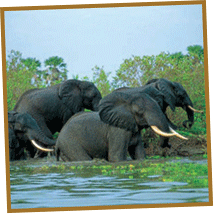 The Western Circuit is the bird watchers paradise. It is heavily forested with mountainous terrain making it an unsuitable habitat for carnivores and safe for walking safaris. The sites we are looking at are:
The Western Circuit is the bird watchers paradise. It is heavily forested with mountainous terrain making it an unsuitable habitat for carnivores and safe for walking safaris. The sites we are looking at are:
Gombe Stream National Park
A mountainous strip that borders the shores of Lake Tanganyika, about 16 km from Kigoma. Tanzania's smallest park covers only 52sq km. It can only be reached by boat from Kigoma. Gombe stream offers visitors the rare chance to observe the chimpanzee communities made famous by the British explorer Jane Goodhall. A number of monkey species can only be seen including the red colubus, red tail and blue monkeys. The area is heavily forested making it an unsuitable habitat for carnivores and safe for walking safaris. Bird watchers will be richly rewarded.
Mahale Mountains National Park
The other sanctuary of the chimpanzee, is also reched by boat from Kigoma. Covering an area of approximately 1,000 sq km, the park's western boundary is the shore of lake Tanganyika.
The chimpanzee population is estimated at around 1,000 and they may be observed in their natural habitat in groups of up-to 30. Baboons and colubus monkeys also live in the park while other animals found there include buffalo, bush pig, elephant, giraffe, leopard, lion, porcupine and various types of antelope. Lake tanganyika is home to more than 250 species of fish.
Rubondo National Park
A water wonderland comprising Rubondo Island and nine smaller islands tucked into a corner of lake Victoria north west of Mwanza. The park provides a variety of habitats ranging from savannah to open woodland, dense forest, papyrus, swamps and sandy beaches.
There is also a variety of animals including bushbuck, crocodile, elephant, genet, giraffe, hippo, mongoose, velvet monkey and the reclusive sitatunga - a shaggy aquatic antelope.
The bird-life is unique with birds from the east, central and southern Africa flocking to 'Bird Island' to breed. Bee-eates, fish eagle, ibis, kingfisher and saddle-billed stork will be seen with tilapia and Nile pearch abound in the lake.
Katavi National Park
Katavi National Park is sometimes described as ‘near’ Mahale, but this must be recognised as a purely relative term with reference to Tanzanian distances! Deceptively accessible on maps, the ‘main’ road through Western Tanzania that runs merrily through the middle of Katavi is by no means a smooth ride.
Despite its great size - 4471 sq km/ 2780 miles square - and its inherent variety of animal and birdlife, it is perhaps one of the most underestimated of all the Tanzanian National Parks, (although those who do set up camp on its plains are quite content to leave it that way!)
The landscape of Katavi, together with Rukwa National Park, was created as a result of a minor fault in the Western Albertine Rift which formed a wide alluvial plain. The park has a central, very flat valley floor which forms spectacular flood plains after the rains, and attracts huge herds to its bounty from the surrounding hills.
Tanzania
